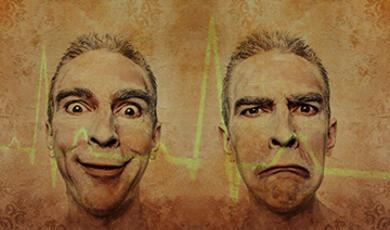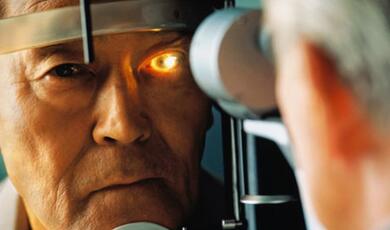In the brain of the beholder? The principles of beauty and sex appeal
Share
- Details
- Transcript
- Audio
- Downloads
- Extra Reading
What constitutes human facial beauty and bodily attractiveness? How do these traits connect with health, fertility, and parental fitness? Differences across time and culture in the attributes that are attractive will be outlined and suggestions made as to what accounts for these variations.
Download Transcript
Glenn Wilson PhD,
Visiting Professor of Psychology
25/01/2010
According to Woody Allen, "only two things in life are important: one is sex, and the other isn't all that important". This is a view that is pretty much shared by evolutionary psychologists, who argue that the key motive is the 'sexual imperative', the need to pass our genes on to the following generation. Genes that do not succeed in reproducing themselves are lost forever. Everything else, including our survival instinct, is subservient to this central aim.
The essential first step is to attract a mate, preferably several to choose among. However, choice is more relevant to women than to men, who can potentially breed with several women in parallel. The issue of mate choice is barely touched upon here because it is the focus of my next lecture. Also, many principles discussed tonight assume heterosexuality, and in that sense I simplify. This is because my third lecture is devoted to sexual orientation.
The first principle of beauty, though 'generalisation' might be a better word, is that female faces are seen as attractive when they borrow baby signals. Among these are smooth, pinkish skin, large open eyes, full lips and a small chin. These traits have apparently been evolved to evoke parental protection from men. Pop songs refer to adult women as 'baby', while pornographers call them 'babes'. Pets use similar infant signals to evoke caretaking in humans. (It is even possible that the tendency for men to go bald as they get older is an appeal to the maternal instinct of their wives after their masculine appeal is no longer credible.) The evolutionary reason for women's adoption of baby-doll features is that women are more fertile, and therefore more valued, when young. The breeding potential of men is less dependent on their age. Toyboys do exist (ask Mrs Robinson) but are rarer and seldom lasting.
As a general rule, facial beauty depends on signals of reproductive fitness. In other words, both men and women look for markers of fertility and good parent potential. Primary among such cues (Rhodes, 2006) are:
Averageness - Since the classic demonstrations of Sir Francis Galton, it is has been recognised that when photos of several faces are superimposed one on another, the composites appear as attractive. This is partly because blemishes and abnormalities are cancelled and the skin appears smooth, hence healthy. Average faces may also signal heterogeneity (out-breeding) which has advantages in breadth of immunity.
Symmetry - When the left and right sides are blended, a face is judged more attractive and having more 'mate appeal'. Symmetry implies 'developmental stability', which refers to a history of resistance to stresses during development, such as mutations, parasites and toxins. This principle applies equally to women and men. There is evidence that the partners of symmetrical men have more orgasms, presumably because such men are more desirable (Thornhill et al, 1995).
Sexual dimorphism - Feminine faces are attractive to men and exaggerations of femininity even more so. While average female faces are attractive, optimal attractiveness has slightly different proportions. These are the hyperfemale traits that are typically emphasised by make-up (bigger eyes, narrower eyebrows, pinker complexion, fuller redder lips, etc.). These are usually the attributes of young, mature women of around 24 years old, although some are younger still (e.g., the ideal lips are those typical of a 14 year girl). Not surprisingly, the composites of female models are more attractive than those based on randomly chosen women. Since these traits are oestrogen markers, composites of women high in oestrogen are judged by men as more desirable than those of women low in oestrogen,
Women are, of course, more complicated in their preferences. Sometimes they like manly, dominant (high testosterone) faces; at other times they prefer a softer look. Perrett et al (1998) found that women often prefer a slightly feminised male face (smaller chin, wider lips, larger eyes and higher arched eyebrows), no doubt because these suggest traits like empathy and reliability that might make for good parenting. Interestingly, the fossil record suggests that sexual dimorphism in humans has diminished over the last 100,000 years, presumably as a result of a female preference for caring men.
Whether a woman prefers a man who is macho or baby-faced, genetically similar or not, depends upon whether she is in long-term or short-term mating mode. There is a shift toward a preference for 'real' men, and those less closely related, when a woman is in mid-cycle, not pregnant, not on the contraceptive pill and when she is engaged in extra-pair mating (having an affair). In other words, when fertile women seek 'good genes', otherwise they favour 'resource provision'. Use of the pill removes the mid-cycle change in mate preference (Alvergne & Lummaa, 2009).
A similar principle applies to reactions to dilated eye pupils. Dilated pupilsare generally attractivebecause they make the eyes look bigger and give the impression that the other person is interested in us. This helps to make a candle-lit dinner romantic - pupils are initially enlarged because the light is dim, but this is instinctively read by the partner across the table as emotional arousal, thus setting up a spiral of mutual desire.
Where men are concerned, the larger a woman's pupils the better. For women, large pupils are only preferred when they are mid-cycle, not on the pill, and are the type likes 'bad boys' (all indicative of a short-term mating mode). When a long-term mate is sought, women prefer medium pupils because the male partner is seen as a better potential parent.
Which is more important in determining physical attractiveness, the body or the face? Currie & Little (2009) had models rated separately for body and face, then the two combined. Overall, the face was the better predictor of overall attractiveness. However, the body component increased in importance when men were considering women for short-term affairs as against a long-term relationship. No such shift occurred when women evaluated men. It is thus not surprising that women regard wandering eyes as a bad sign in a man.
Males seem to be more excited by female beauty than vice versa. Cloutier et al (2008) found that brain reward circuits in the nucleus accumbens and orbitofrontal cortex showed greater fMRI activation (signal change relative to baseline) when people viewed attractive faces relative to unattractive faces. However, males responded more differentially (especially in the OFC, where females did not distinguish at all). This confirms the widespread idea that, where sexual matters are concerned, men are more visual animals than women. However, women differentiate more than men in the smell channel.
Sex appeal is not the same as beauty and is perhaps more complex. Some years ago, She magazine asked a number of celebrities to define sex appeal. The answers were various: 'satin sheets' (Lionel Blair), 'blue eyes and blue jeans' (Elizabeth Emanuel), 'mystery and subtlety' (Michael Aspel), 'animal odour and body language' (Paul Daniels), 'Orson Wells' (Anna Raeburn), 'really well-pointed brickwork' (Michael Palin). This illustrates the fact that sex appeal can be idiosyncratic; nevertheless, some general rules can be adduced.
By and large, sex appeal derives from the typical differences between men and women, for example, the female hourglass figure versus the V-shaped torso of men, the greater height and depth of voice of men, and the 'musky' smell of men versus the 'sweet' smell women. These are markers of sex hormones (especially oestrogen versus testosterone) and they signal reproductive fitness.
For women, a key marker of fertility is the waist/ hip ratio. Low ratios, with the waist much narrower than the hips (ideally .7 to .8) are attractive to men because they indicate high oestrogen. By corollary, a tight, compact backside in a man is preferred by women. Strangely, women even seem to prefer it in themselves, being famously concerned about whether 'their bum looks big' in whatever they are wearing. Perhaps they would be more reassured by reading some evolutionary psychology than soliciting their partner's opinion.
Ethologists (scientists who study animal instincts) have shown that all species are equipped with certain innate releasing mechanisms - stimulus patterns that are primed through evolution to evoke behaviour of survival importance. For example, humans readily acquire a fear of snakes and spiders because they were particularly dangerous to our ancestors, whereas we don't fear cars half as much as we should.
The human male seems to have an innate tendency to be turned on by paired, pink, fleshy hemispheres. Desmond Morris has argued that breasts excite men because they 'echo' the rear presentation signal that is a key IRM for the human male. Support for such an idea comes from observation of certain primates, such as the gelada baboon, in which the female has copied her rear configuration onto her front side for purposes both of sexual titillation and appeasement.
Such innate visual templates are subject to modification and consolidation in early childhood in accord with what is actually experienced in the environment. This is called imprinting, and it accounts for some cultural variability as well as attachments to inappropriate targets that we dubfetishism. Fetish objects are not determined by random conditioning; they nearly always have a strong sensory or symbolic association with the innate releaser. For example, a black high-heeled shoe is roughly the shape, colour and size of the pubic triangle; it traps pheromones after being worn, and has dominant, adult female (superbitch) connotations. Not surprisingly, shoe fetishists are more common that lawn-mower fetishists. Shoe fetishists are also more common than hat fetishists, which perhaps connects with the fact that shoes are more prominent in the sightline of a crawling infant than hats (infancy being the time when fetishisms are established).
Both men and women display in order to attract mates. Nightclubs operate as human leks (sexual display grounds). Observations of people going in and out of nightclubs show that 50% more people leave as couples than arrive together. Males approach females in accordance with the tightness of their clothes, the amount of fleshthey expose (especially in the breast area) and the provocativeness of their dancing. These, in turn, vary with the phase of their cycle. When fertile, women wear sexier clothes, display more flesh and dance more provocatively. The most successful females display at least 40% of their body and 50% of their breast area (Hendrie et al, 2009). The limit of exposure is apparently the point where 'allure' becomes 'brazenness' (signalling promiscuity and possibly inviting rape). Women choose among the males brave (dominant) enough to ask them to dance.
Male displays are more focused on demonstrations of power and achievement (c.f., the colourful constructions of the New Guinea bower bird). A man shown seated in a Bentley Continental is rated as more attractive by women than the same man in a Ford Fiesta (Dunn & Searle, 2009), whereas men are little influenced by such status manipulation in their judgements of women. However, men do seem to recognise when they are impressing women - their testosterone increases after driving a Porsche in public and decreases after driving a banger (Saad et al, 2009).
Clearly, wealth and status are more important markers of 'mate value' to women than physical good looks. In fact, body builders are likely to be seen by women as self-absorbed narcissists. Intelligence, creativity, sense of humour and generosity (willingness to share resources) are, however, highly rated by women.
It is widely supposed that eligibility in a man depends on his availability. But this is another respect in which women are complicated. Single women complain that 'all the good men are taken' but the truth seems to be that being already taken makes a man more attractive. Parker & Burkley (2009) found that single women were more attracted to a man if they thought he was already attached. No such 'mate poaching' preference was observed for either men (who pursue female targets indiscriminately) or attached women (who prefer single targets).
There is much consistency across cultures as to who is attractive. The principles of averageness, symmetry, sexual dimorphism and familiarity apply equally in non-Western cultures. Infants (2-3 months old) share the same standards of beauty as adults, preferring to look at faces that adults find attractive (Langlois, 2000), so standards of beauty cannot be just cultural artefacts. Biological factors (evolved instincts) must be at play, and as we have noted, these universal preferences derive from signals ofmate quality (indications of youth, health, fitness and fertility).
Some variations across time and place do need accounting for. Generally, they relate to more social aspects of mate quality (signals of wealth and status). For example, the value of a suntan has varied throughout history. Pale skin was sought in Elizabethan days because exposure to the sun implied peasant status. Since the industrial revolution, a suntan became valued because workers were confined to mines and factories, while the rich could afford foreign holidays. Thinness (to the point of anorexia) is prized in Western society, though by women more than men. Models appearing in women's magazines are thinner than those that adorn the pages of men's magazines. Fatness of the kind associated with Turkish belly dancers may be valued where food privation means that only the rich can get fat. Youth is prized in Western society; less so in tribal cultures that venerate elders, where pendulous breasts may be preferred over those that are pert.
We tend to value traits that are typical within our own group - hairiness in Scots, smoothness in Chinese, large breasts in Hollywood and the protruding buttocks of Hottentot women. This could be the origins of racial and species divergence and it raises another explanation as to why average faces are attractive. According to prototype theory, we are most comfortable with patterns we have come to expect, since these are easier to process in the brain. Winkielman et al (2006) demonstrated thisexposure principle with abstract stimuli (patterns of dots) but believed it would generalise to human beauty.
Familiarity is a learning mechanism that could help to explain genetic similarity attraction (the tendency to prefer those closely related to and resembling ourselves) as well as idolisation (obsession with celebrities, even those that are totally empty).
No doubt avatars of beauty are affected by experience and media repetition though that is not the whole story.
An interesting historic variation in standards of beauty is described by Pettijohn & Jungeberg (2004). They found that men's perception of sex appeal depends upon a nation's economic health. Playboy models tended to be more big-eyed, petite and feminine during good times; more mature and motherly in times of economic difficulty. Apparently, we seek fun when things are going well and support/security when times are bad. Only thus can current appeal of Anne Robinson.
Conclusions
Human evolution is driven by sexual selection as much as by natural selection.
What we are today is partly the result of the sexual preferences of our ancestors.
Beauty and sex appeal are not inherent in stimulus patterns but rooted in our responses. They are based primarily on signals of health, reproductive and parental fitness, although familiarity may also contribute. We are seldom conscious of the adaptive value of our choices but simply go on 'instinct'.
Finally, we should not make the mistake of assuming the opposite gender thinks like ourselves. Men and women differ in the field of mating and dating perhaps more than any other. There is much truth in the adage that 'men are only after one thing, whereas women are after everything'.
©Professor Glenn D Wilson, Gresham College 201
Alvergne, A. & Lummaa, V. (2009) Does the contraceptive pill alter mate choice in humans? Trends in Ecology and Evolution, in press.
Currie, T.E. & Little, A.C. (2009) The relative importance of the face and the body in judgements of human physical attractiveness. Evolution and Human Behaviour, 30, 409-416.
Dunn, M.J. & Searle, R. (2009) Effect of manipulated prestige car ownership on both sex attractiveness rating. British Journal of Psychology,in press.
Hendrie, C.A., Mannion, H.D. & Godfrey, G.K. (2009) Evidence to suggest that nightclubs function as human sexual display grounds. Behaviour, 146, 1331-1348.
Langlois, J.H., et al (2000) Maxims and myths of beauty: A meta-analytic and theoretical review. Psychological Bulletin, 126, 390-423.
Parker, J. & Burkley, M. (2009) Who's chasing whom? The impact of gender and relationship status on mate poaching. Journal of Experimental Social Psychology, 45, 1016-1019.
Perrett, D. I., Lee, K.J., Penton-Voak, I. & Little, A.C. (1998) Effects of sexual dimorphism on facial attractiveness. Nature, 394: 884-887.
Pettijohn, T. (2004) Playboy Playmate curves: Changes in facial and body feature preferences across social and economic conditions. Personality and Social Psychology Bulletin,
Rhodes, G. (2006) The evolutionary psychology of facial beauty. Annual Review of Psychology, 57, 199-226.
Saad, G & Vongas, J.G. (2009) The effect of conspicuous consumption on men's testosterone levels. Organizational Behavior and Human Decision Processes, 110, 80-92.
Thornhill, R., Gangestad, S.W. & Comer, R (1995) Human female orgasm and fluctuating asymmetry. Animal Behaviour, 50, 1601-1615.
Winkielman, et al (2006) Prototypes are attractive because they are easy on the mind. Psychological Science, 17, 799-806.
This event was on Mon, 25 Jan 2010
Support Gresham
Gresham College has offered an outstanding education to the public free of charge for over 400 years. Today, Gresham plays an important role in fostering a love of learning and a greater understanding of ourselves and the world around us. Your donation will help to widen our reach and to broaden our audience, allowing more people to benefit from a high-quality education from some of the brightest minds.


 Login
Login







